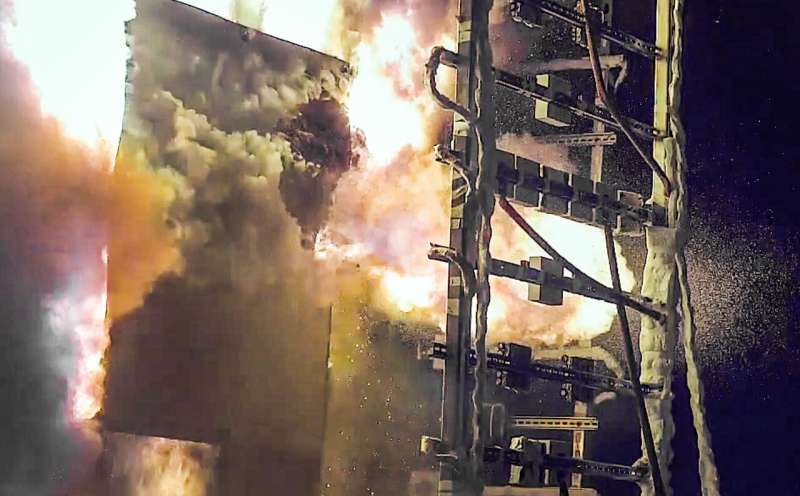High-speed fire footage reveals key insights for power plant safety

High energy arcing faults are high-power electrical discharges between two or more conductors that can release tens of thousands of amps of current. They can result in explosions that reach about 35,000 degrees Celsius—about the temperature of lightning strikes—and vaporize steel and spew hot metal particles into the air.
In a power plant, such a fault can quickly spread, which is just the thing Sandia National Laboratories researchers are trying to prevent by finding a new way to peer into the flames. Those flames are filled with useful information that can help keep power plants operating safely.
Sandia fire protection and optical engineers are using high-speed cameras and advanced algorithms, imaging and analytic methods to understand these dangerous arc faults between two conductors, such as the high-voltage bus bars in a switchgear at a power plant.
Power plants evaluate risks from arc faults by knowing their zone of influence—the distance that neighboring cables and equipment would be damaged beyond functionality. In a nuclear power plant, this helps engineers evaluate the potential of damaging the reactor core if the neighboring equipment plays a role in safely shutting down the reactor.
But precise data about a rapid arc fault is hard to collect. Bright flames and smoke obscure the view, and the high heat destroys many diagnostic instruments. The electromagnetic interference associated with the flash also impairs the ability to collect data.
Sandia optical engineers have a way around those challenges. They often train high-speed cameras on fiery tests at Sandia's blast tube and rocket-sled track. Now they've turned their lenses toward arc faults at power plants.
Working with Sandia fire protection engineers and colleagues at the National Institute of Standards and Technology, the group recently participated in large-scale tests at an independent lab in Pennsylvania. The project is funded by the Nuclear Regulatory Commission.
Data from the tests will enable a computer model to be developed that will predict an arc fault's zone of influence. The results could be applied to low or medium voltage cabinets at any facility, said Chris LaFleur, a fire protection engineer who led the Sandia effort.
Footage reveals arc faults' power and intensity
Conductors running though these electrical cabinets were traditionally made of copper, the metal on which zones of influence have been determined over the past 50 years. But recently, it has been identified that many bus bar systems have used aluminum conductors or a combination of copper and aluminum. Aluminum, while less expensive and lighter than copper, is much more reactive during a high energy arc fault. This difference can affect how much energy and material an arc fault emits.
To learn about the impact of an arc fault in a full range of electrical equipment with both copper and aluminum conductors, the researchers took their commercial high-speed and infrared cameras to KEMA Laboratories in Chalfont, Pennsylvania, an independent testing lab with unique electrical equipment capable of generating high energy arc fault conditions.
Optical engineer Anthony Tanbakuchi and lead technologist Byron Demosthenous put the cameras behind a cinder-block wall to get them close to the arc fault while also protecting them from the heat. They pointed the cameras toward high-grade mirrors and recorded the reflection of the explosion at more than 1,000 frames per second.
The team recorded an arc fault that lasted four seconds with 26,000 amps of current. Reviewing the high-speed footage, the researchers saw how the steel panel enclosing the switchgear vaporized within half a second of the arc initiation.
"In seconds, a perfectly good cabinet was destroyed," LaFleur said.
One video, several perspectives
Sandia's optical engineers have developed advanced imaging and analytic methods to show several kinds of data in one video. After collecting video during a test, the group uses algorithms to stabilize and merge footage from multiple cameras.
For the arc fault tests, the fire protection engineers wanted to see through the smoke and monitor the temperature of the flames. So, Tanbakuchi and Demosthenous also filmed the explosion using thermal imaging. Then, they combined that footage with a view from a high-speed camera recording visible light from the explosion. The results showed the temperature profile of the explosion relative to the physical equipment without smoke obscuring the view. These efforts allow the researchers to be able to use video as test data.
Another challenge involved accounting for bright flames and shaking cameras. Tanbakuchi and Demosthenous set up three high-speed cameras to record the explosion. Each was set to a different exposure, so that combining the views produced high dynamic range footage with more detail in the bright and dark areas of the image. Then they stabilized the footage with a specialized computer program. The result was a video with enough visual contrast to see where the ejected particles at the edge of the explosion traveled. The particles' movement helps LaFleur track how the explosion turns energy into speed, momentum, chemical reactions and electrical energy.
Sandia researchers also mounted small rectangles of carbon tape and silica aerogel at various distances in front of the explosion. Ejected particles stuck to these materials, which they took back to their lab for further analysis. The size, shape and chemical composition of the particles provides clues to reactions that occurred during the explosion.
LaFleur and her colleagues are hoping to use data from these tests to create a computer model that accounts for the energy, mass and momentum balances during an arc fault. Then the researchers can create a table that provides the zones of influence for a high energy arc fault of given voltages and currents in a cabinet with specific metal conductors. This information can help nuclear power plant operators do risk analysis, she said.




















